There’s a lot of tinkering going on in the shop at Zeta6 these days.
The innovative company, which brought us a host of interesting variations on the strip loader concept, has been hard at work expanding their product line, and we’re happy to share the latest developments here with you at RevolverGuy.
J-CLIP-R
The first of the new products from Zeta6 is a version of their very interesting J-CLIP design, sized for the popular Ruger LCR revolvers chambered for .38 Special and .357 Magnum.
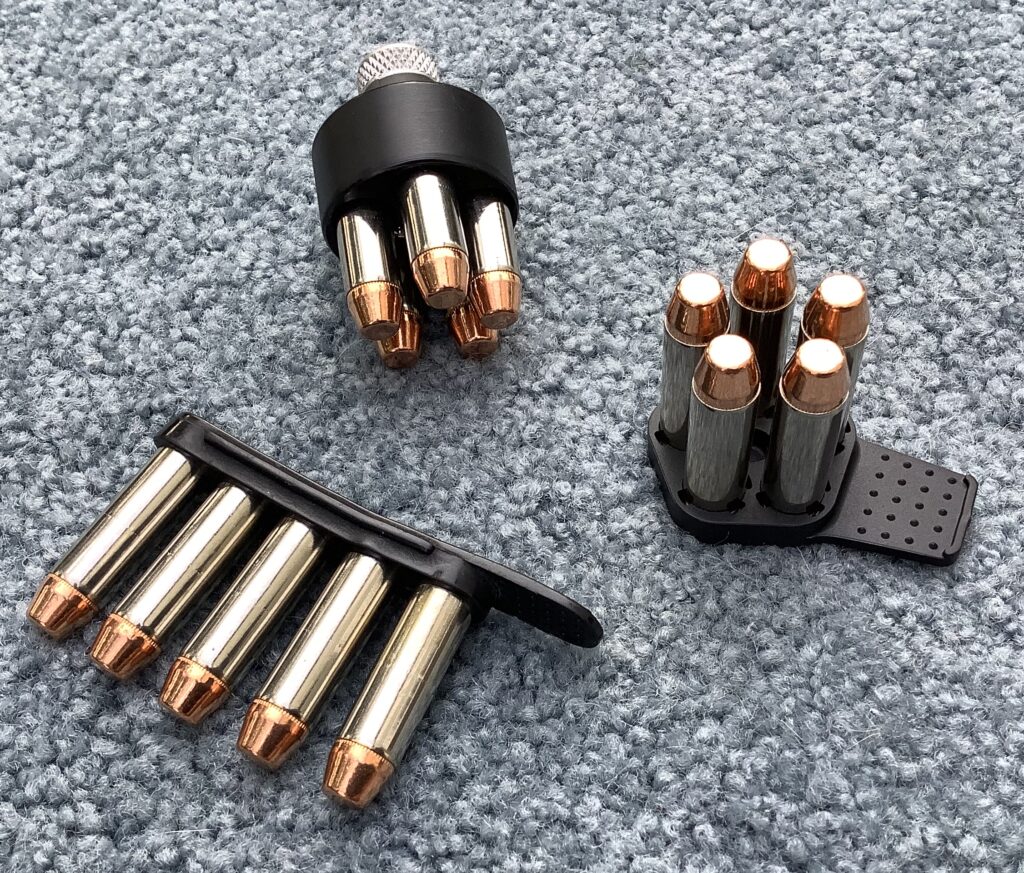
Justin tested the J-CLIP in these pages before, but for those of you who missed that review, the J-CLIP is an interesting hybrid between a round-body speedloader (like the ubiquitous HKS or Safariland Comp) and an inline strip loader (like the trendsetting Bianchi Speed Strip, or the later versions from Tuff Products, DeSantis, and Galco). In the J-CLIP, the rounds are held in the same pattern as the chambers of the cylinder, just like you’d see in a round-body speedloader. However, instead of relying upon a knob or button to release the payload, the flexible J-CLIP is simply peeled away from the cartridges, using the same motion you would use with a strip loader.
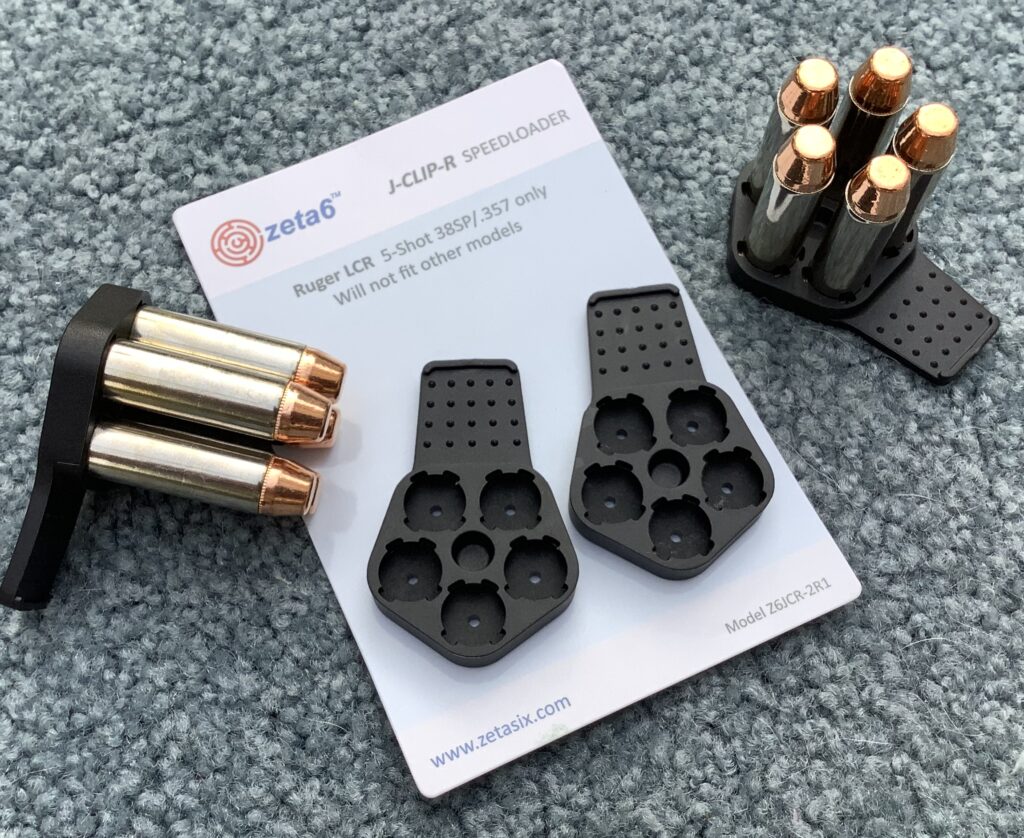
When Justin tested the J-CLIP previously, he was pleased to discover that it was almost two seconds faster than using an inline strip loader, and seemed to be less noticeable in the pocket than a round-body speedloader. After playing with the newly-released J-CLIP-R for the Ruger LCR, I’ll second those observations, and will also add that the J-CLIP-R neatly solves one of the problems with carrying a round-body speedloader loose in the pocket, in that you don’t have to worry about pocket lint or other debris jamming the release mechanism. The “solid state” design of the J-CLIP and J-CLIP-R is as simple as it gets, and with no moving parts, it’s like the AK of round-body loaders—it’s simple, robust, and gets the job done.
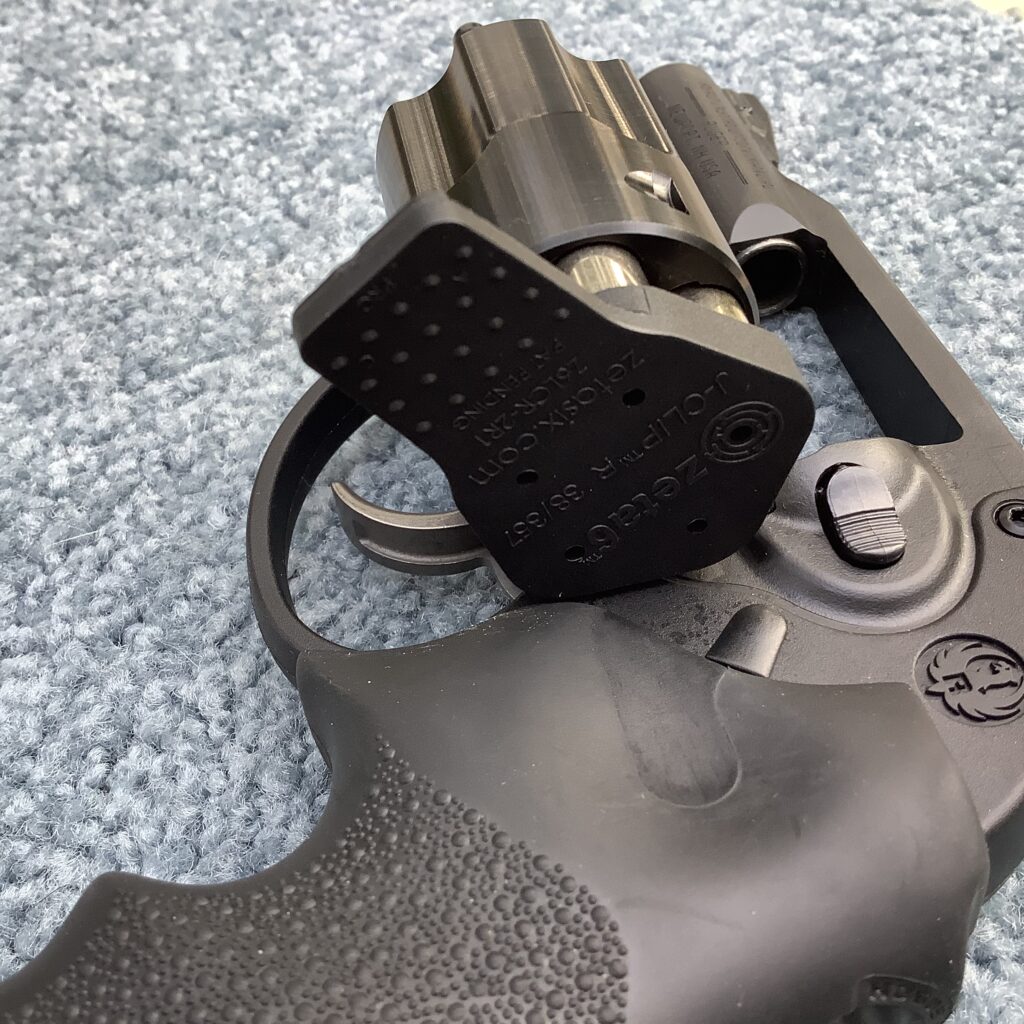
I was pleased to see that the J-CLIP-R cleared the profile of the excellent Hogue Tamer grips that are standard on the LCR. The Hogue grips are an essential part of the LCR’s magic, and I can’t imagine using anything else. However, they’re not particularly amenable to modification—you can’t really sand them down like a pair of wood stocks that are too proud—so if your loader doesn’t clear them, you’re kind of out of luck. Fortunately, the pentagram-shaped base of the J-CLIP-R neatly clears the side of the Hogues and lets you get the loader mated up without difficulty—something that’s not always accomplished so easily with the round-body speedloaders. Score one for the J-CLIP-R!
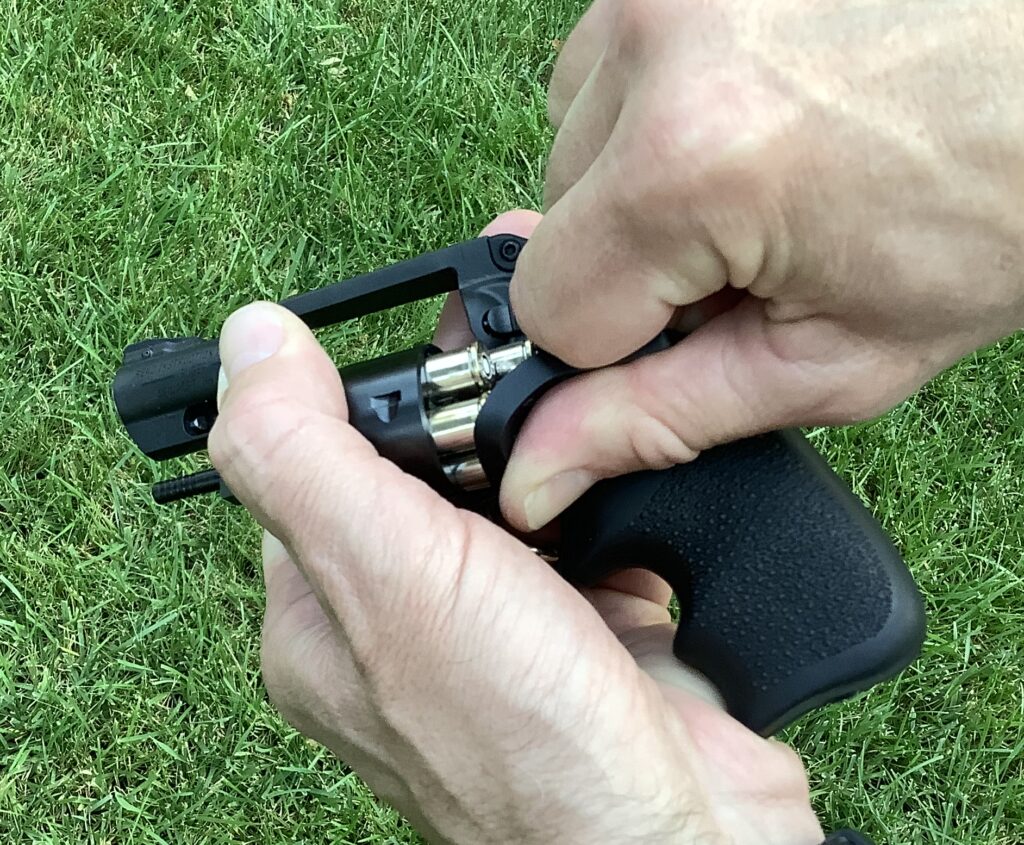
Alas, I did notice the same tendency that Justin noted, to pull a round out of the chamber when peeling the loader away from the cylinder. Honestly, I’ve done the same with a multitude of round-body speedloaders and inline strips, but it is something to pay attention to as you start working with the J-CLIP-R.
To get another opinion, I gave a set of J-CLIP-R loaders to a faithful RevolverGuy reader who carries a .357 Magnum-chambered Ruger LCR. She took them to Tatiana Whitlock’s Handgun Accuracy class and gave them a good workout. Upon her return, she told me the J-CLIP-R was now her favorite loader for the gun! She praised its compact size and ease of use, and said she was much faster with the J-CLIP-R than with her inline strip loaders or 5-Star, round-body loaders. I think Zeta6 is onto something here, with this design, and you should definitely check it out if you carry an LCR.
K-PAK
The new K-PAK from Zeta6 is like the J-CLIP-R in that it blends the features of several loader types into one.
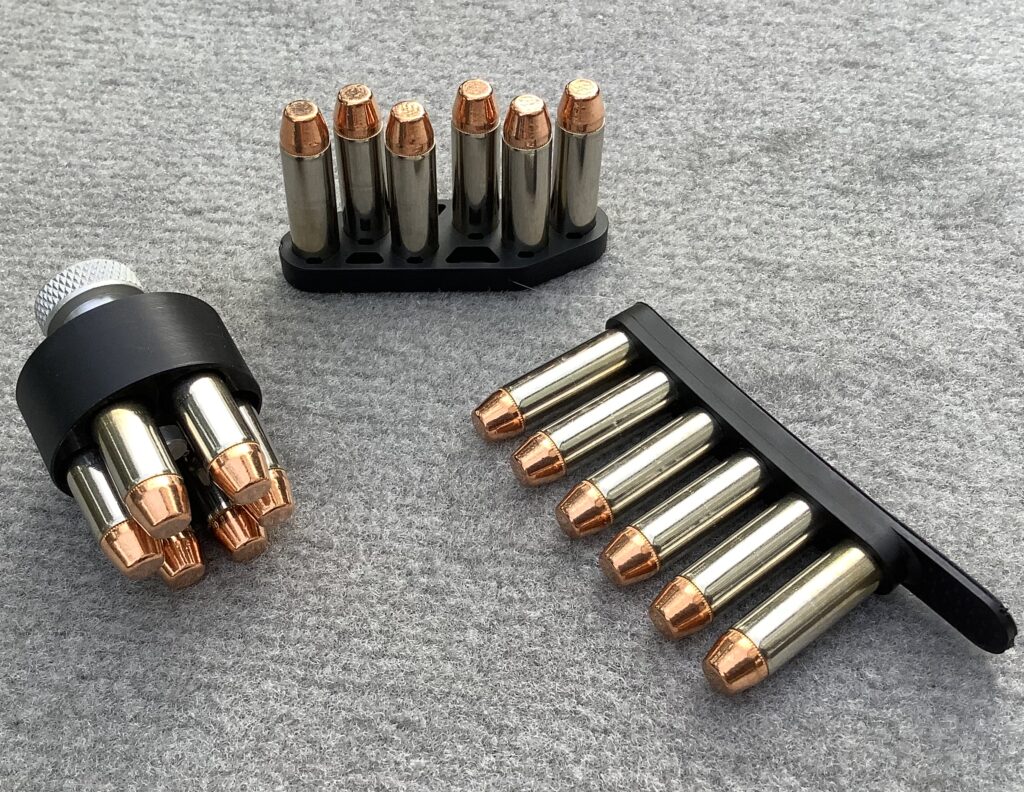
Like the strip loaders and J-CLIP that came before it, the K-PAK is a flexible loader that’s peeled away from the cylinder to release the payload. However, the arrangement of the cartridges in the K-PAK is unique—they’re not held inline, nor in a circular pattern, but instead are held in a pair of arcs, as if someone glued a pair of half-moon clips side-by-side on a piece of flexible polymer.
Whereas the inline strip loaders might allow you to get a pair of cartridges into the cylinder at the same time, the K-PAK is designed to allow you to fit three cartridges at once, just like popping a half-moon clip into the cylinder. Once the loader is peeled away, you repeat the process a second time with the remaining arc of three rounds to finish filling the cylinder.
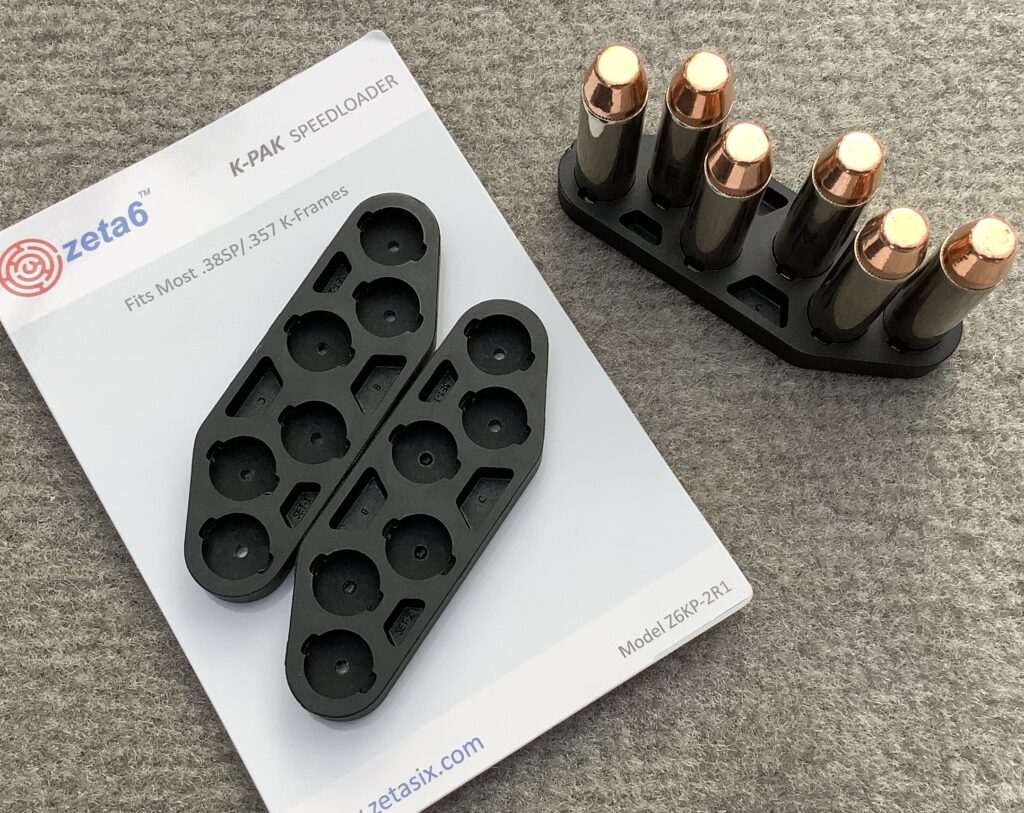
The trapezoid-shaped K-PAK is optimized to clear grip panels without interference. There’s not a lot of extra material around the border, and the angular ends allow you to feed the loader into the cylinder without much drama from fat target stocks. The trim edges of the loader also help to make it less bulky for carry.
However, that narrow rim doesn’t give you much to grip, and there’s no dedicated tab on either end to gain a purchase. As a result, you’ll need to grab the half of the loader that’s not inserted into the cylinder to peel it away. It’s a slightly different feel than you’re used to with a tabbed, inline strip loader.
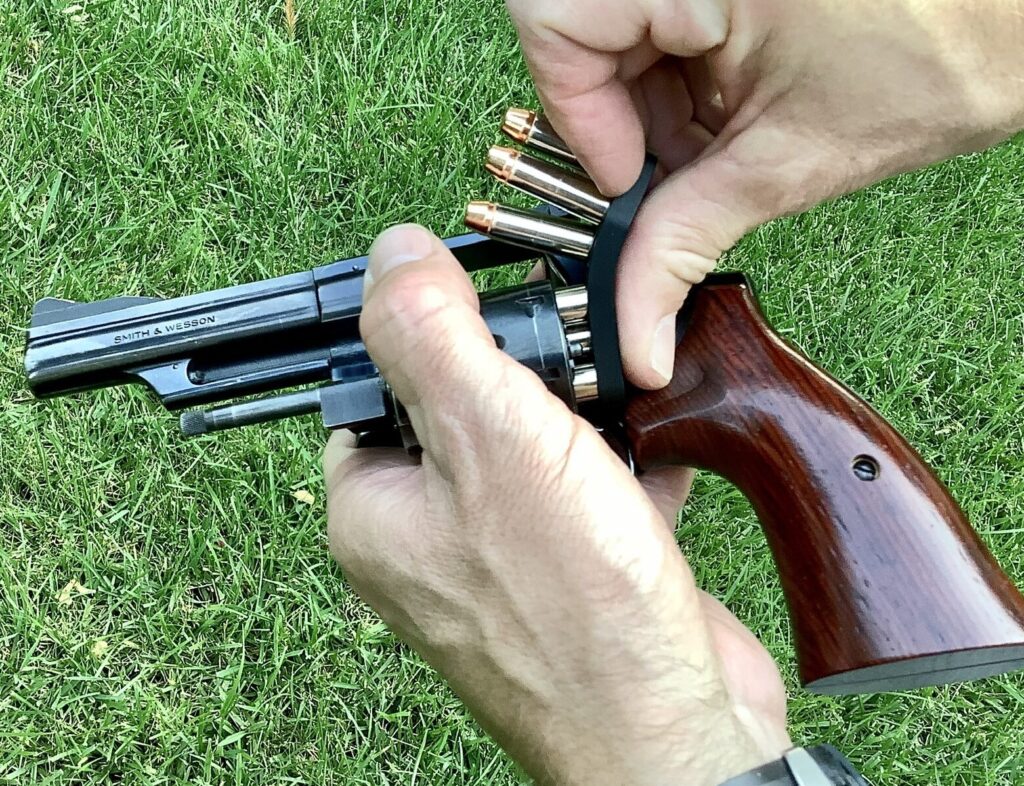
In working with the K-PAK, I discovered that you need to use it differently than other strip loaders. It’s a unique tool, and it requires its own “manual of arms,” so to speak.
The most significant difference is that you’ll need to release your grip on the loader and flip it upside down halfway through loading.* This is necessary because the arrangement of the cartridges in the K-PAK won’t match the chambers in the cylinder unless you invert the loader after filling the first half of the cylinder.
If you’re loading with an inline strip loader of traditional design, you don’t normally have to flip the loader. Imagine you’re holding one of these with your thumb (or fingertip, if you prefer the “scalpel” method) over the end with no tab. You load two rounds in, peel away, then rotate the cylinder. You slide your thumb (or finger) down the spine, and repeat the process, peeling in the same direction. When you get to the last rounds in the strip, the little tab at the end will give you enough purchase to continue peeling in the same direction–no flipping required.
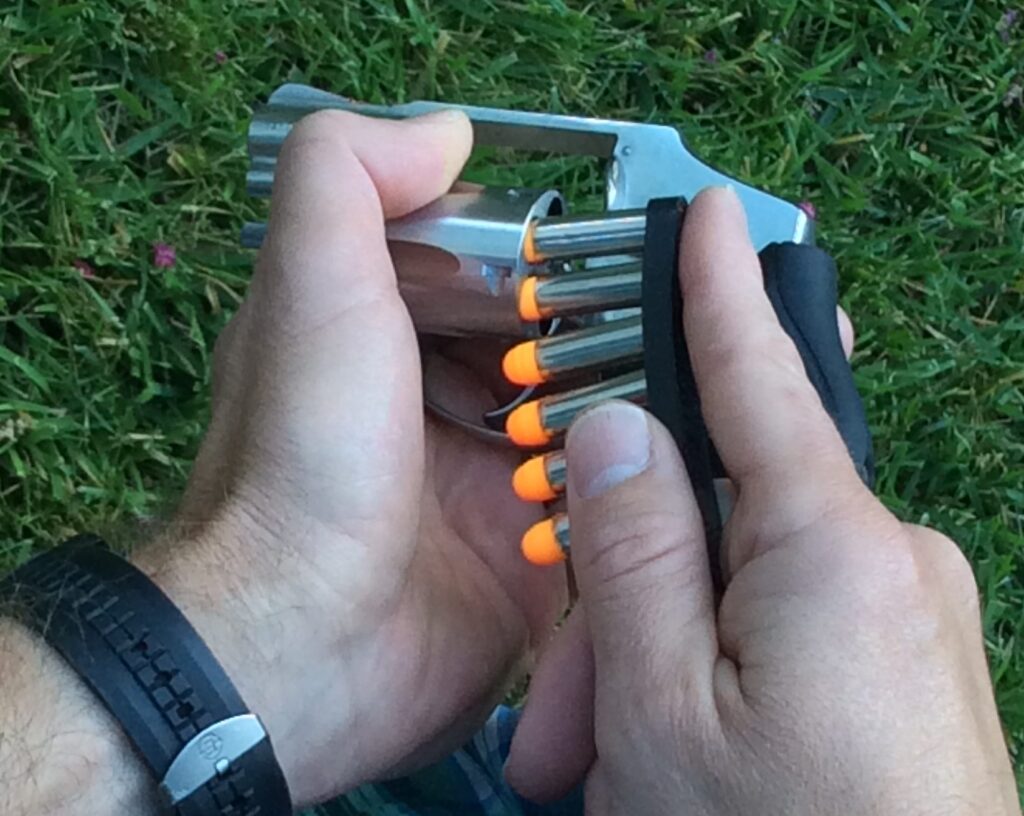
You can’t do that with the K-PAK, however. Because the cartridges are aligned in two opposing arcs, you’ll need to flip it upside down between insertions, to make the cartridges line up with the outside chambers.
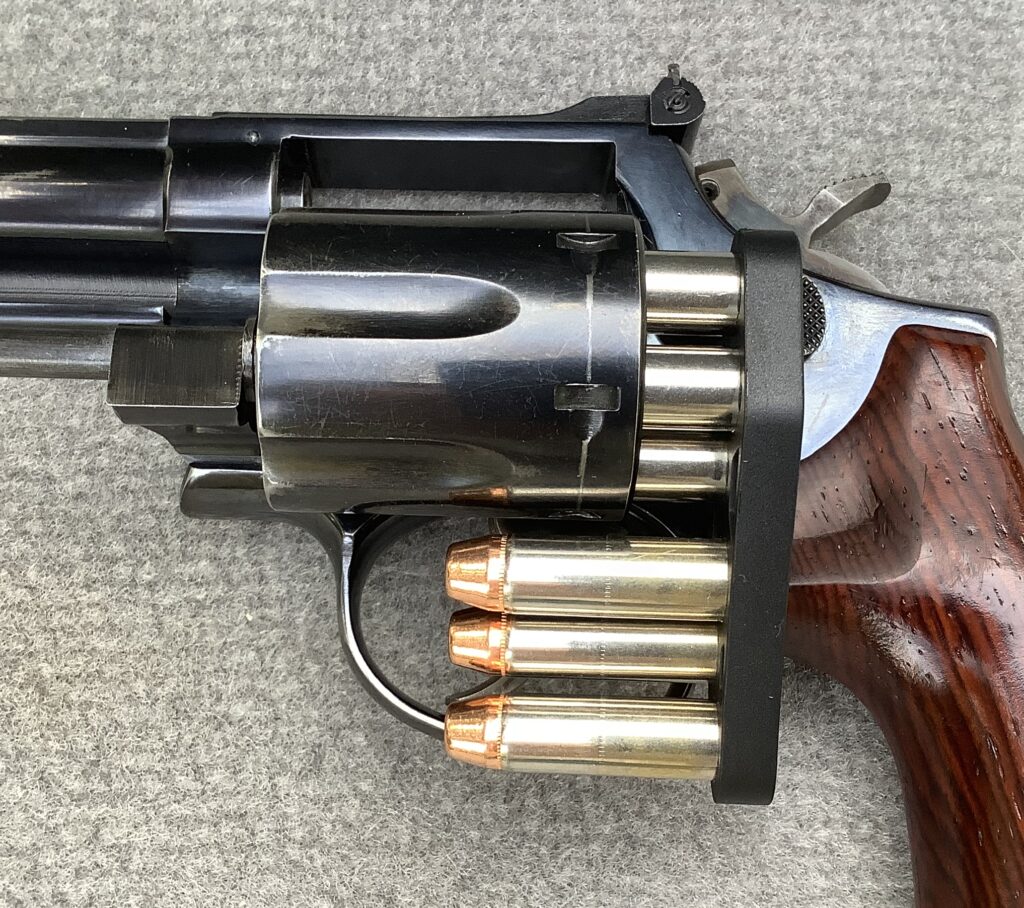
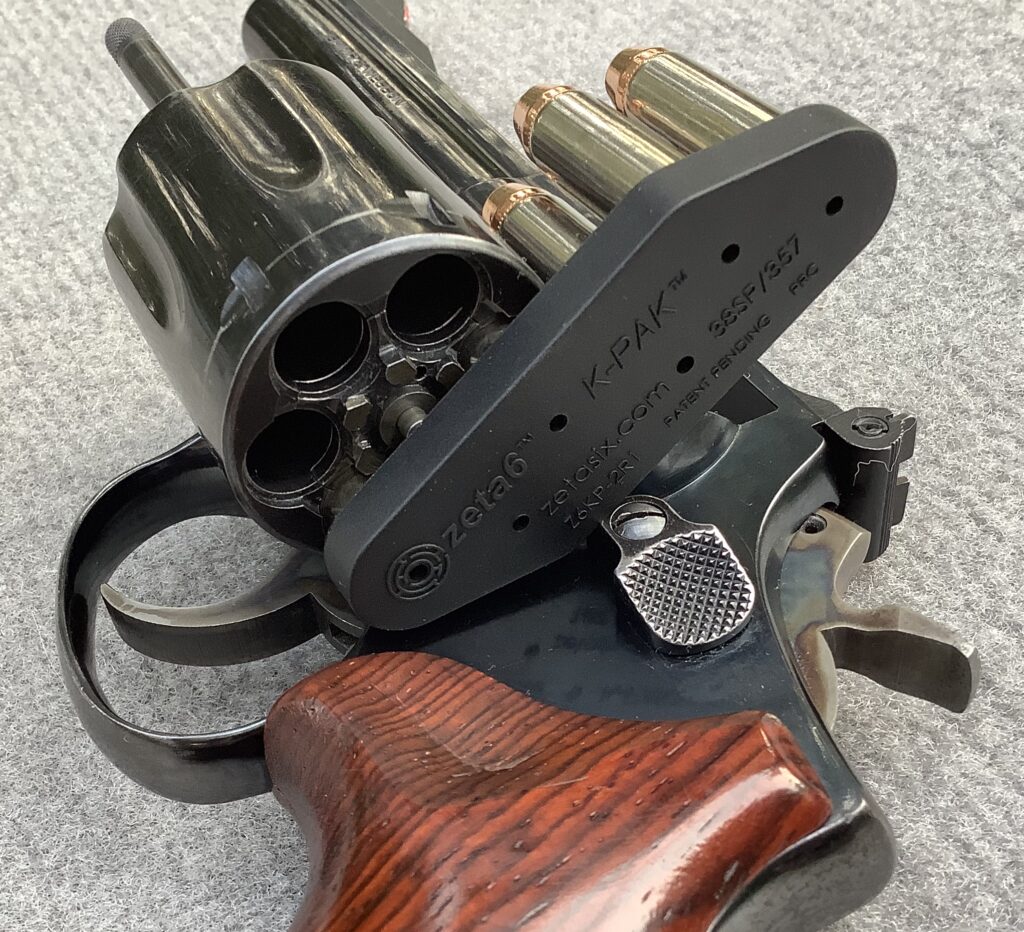
To explain, the K-PAK will be inserted into the outside half of the cylinder on the first go, and peeled away to load the first three cartridges. Once this is done, you’ll rotate the cylinder half a turn to place the empty chambers on the outside, again. At this point, if you try to mate the K-PAK to the cylinder without flipping it upside down first, you’ll find that the arc of the remaining cartridges in the loader is opposite the arc of the empty chambers–you can’t get there from here!
A quick inversion of the loader will fix the problem, though. Flip it upside down in your hand, and the cartridge arc will now mate with the empty chambers, and you can proceed with loading the second half of the payload.
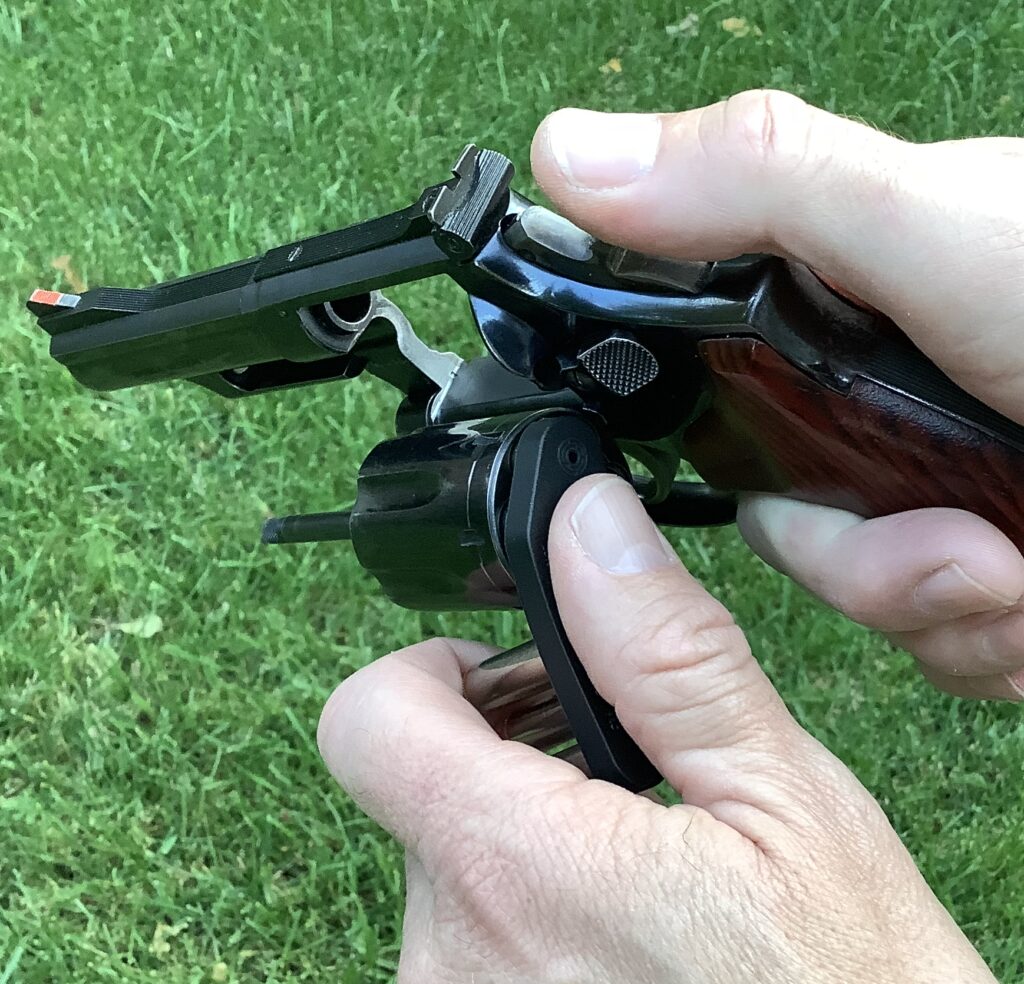
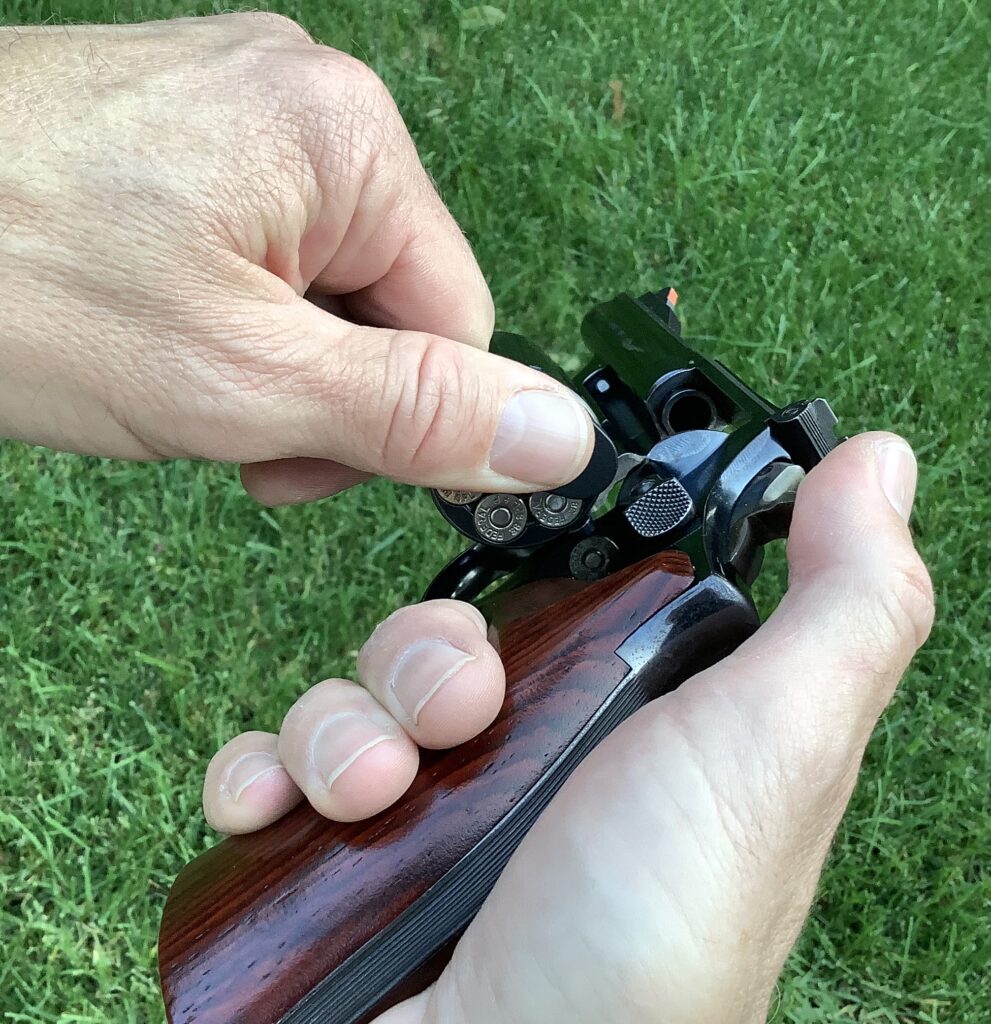
This can take some getting used to, and there’s a potential you might fumble the loader as you flip it over during a moment of stress, so it will definitely require a lot of repetitions to hardwire it into your brain and make it stress resistant.
Another unique quality of the K-PAK is that if you grip it in your right hand, the arc of the cartridges under your thumb mates up to the inside half of the cylinder. It doesn’t matter which end you’re holding, the arc will only match up to the inside chambers of the cylinder.
However, if you hold the loader in your left hand, the arc of the cartridges under your thumb is perfect for loading the outside chambers of the cylinder. Because we tend to favor the outside chambers first for loading (since there’s more clearance), the K-PAK is truly designed for people who load with their left hand.
I have to admit I struggled with the K-PAK loader in my trials. I’ve been building habits for many decades that are incompatible with the way that the K-PAK is used, and I found myself getting frustrated very quickly. I’m habituated to transferring the gun to my left hand and loading with my right, and I’m not used to having to flip the loader in the middle of using it. The K-PAK required a whole new set of skills, and if I slowed things down, I could successfully load with the K-PAK in my non-dominant left hand, but it felt awkward to me after a lifetime of using my right hand to load.
Ugh. I guess if I was starting from scratch, I could learn the new pattern, but trying to force it against ingrained habits was awkward and slow. I could tell the Version 2.0 K-PAK was not a good fit for my Version 1.0 brain! I would have been much better off using Zeta6’s more traditional J-STRIP or SYM-STRIP products, which offer subtle enhancements on the inline strip loader concept. Those tools are a better match for my existing habits.
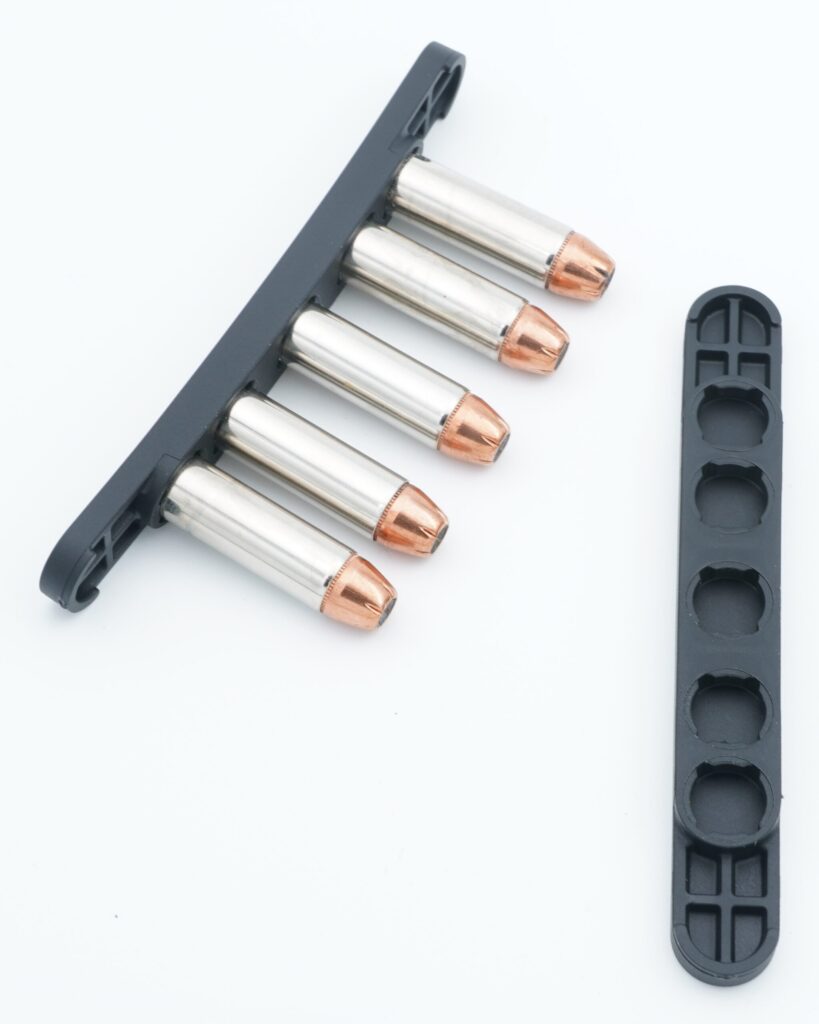
I don’t mean to sour anybody on the K-PAK concept. It’s a viable tool, and offers some unique advantages over round-body and inline strip loaders, but you can’t use it like those other products—it has its own manual of arms that you have to perfect. This old dog wasn’t up to the challenge of learning new tricks, but I’m sure some of you young pups could get the hang of it quickly, and benefit from the advantages offered by the K-PAK. If you’re already a left-hand loader, then you’ll probably warm to the K-PAK quickly. Give it a try and let us know what you think.
Innovation
I’ve got to hand it to Michael Lyle and the team at Zeta6. They’re certainly not afraid to experiment and suggest new alternatives to accomplish the age-old task of reloading a revolver. They’re one of the few companies out there trying to be innovative with revolver loader technology, and they’ve managed to create some products that are definitely worth a look. Plus, they’re really nice guys. Good people, there.
Stop by the Zeta6 website with an open mind and have a look around. You might just find your next revolver loader there!
*****
Note
* There’s actually a way to load with the K-PAK that doesn’t require flipping the loader, but I think it’s more awkward. It’s possible to load the outer half of the cylinder, and–without rotating the cylinder–load the inner half of the cylinder, without flipping the loader over. This requires you to set the loader on the outside half and peel up, then set the loader on the inside half and peel down. You don’t have to flip the loader, but you do have to change your grip a bit to place it on the inside half and peel down, and it just doesn’t seem to flow as well. The K-PAK is relieved enough that you can place it on the inner half without getting hung up on the grip panel, but you might have to turn the cylinder a bit to make it line up right. I mention this method for the sake of being complete, but I honestly don’t think it’s any better than flipping the loader and doing all your loading into the outside chambers.

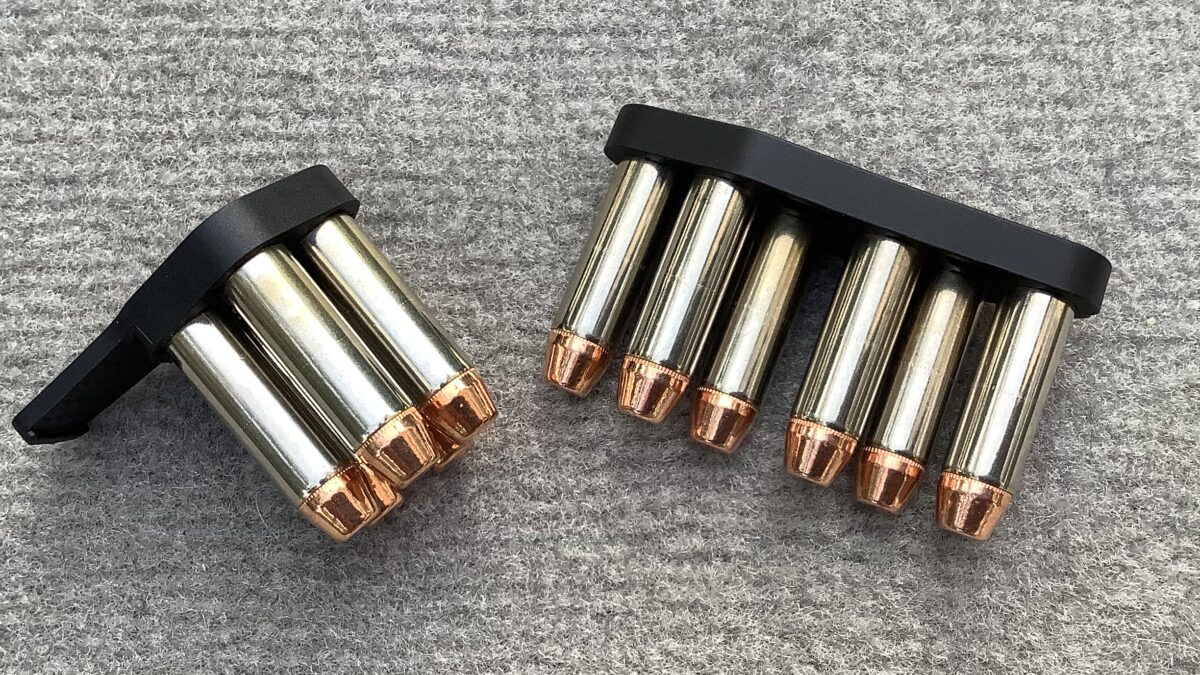
Flipping the loader upside down is slow and awkward on the range; in a fight it might be difficult to impossible due to shaking and clumsy hands. And loading the “outside three chambers” first, then going to the “inside three,” means that if you only have time to load the “outside three” and you’re carrying a Smith or a Ruger, you’ll have to either spin the cylinder before closing the gun or snap on three empty chambers before you get a bang.
Thanks Mike, for highlighting zeta6 and the stuff they’re doing. It’s very gratifying to see companies introducing support gear for carry revolvers! As you and Justin have pointed out in the past, the biggest frustration that revolver guys face these days is the indifference of the industry towards our craft. Big props to zeta6 for hooking us up. Good read, Sir!
Thank you Mike for the very nice write-up.
Have a few questions for you and (I’m guessing?) Wheelgun Judy regarding the J-Clip-R review:
1) Did the ‘failure to peel’ (FTP) happen on the same round every time or did it vary?
2) Had the loader been in your pocket or one the bench? Wondering if it would be more pliable with body heat if it had been in your pocket as opposed to being on a bench maybe alleviating the ‘failure to peel’ (FTP).
Thanks again to you Mike and the Wheelgun Judy.
Mike (not Mike Wood)
Hi MnMW, great to hear from you! The problem I experienced was with a loader that had not been warmed by body heat. It was just ambient temperature, in the high 70s, low 80s.
As a right hander, I cradled the gun in my left hand, with the port side up and the muzzle pointed downwards at about a 45 degree angle. I fed the loader into the cylinder with the tab pointing around the 12 O’Clock chamber, with fingers wrapped around the tab and my thumb on the back of the loader. When I peeled away and down, the cartridge in the chamber near 3 O’Clock or 9 O’Clock (more frequently, 3) would sometimes want to pull out as I peeled the loader off.
This could probably be remedied by some practice, or another method of operation. I didn’t work with the loader enough to perfect its operation.
After writing this piece, Judy took the loader to another defensive pistol class (other than the one I’d mentioned) and had great success with it. She said she’s packed up her 5-Star loaders, since she won’t be needing them now, as the J-Clip-R proved superior.
Hi Mike, thanks for the warm greeting.
I know Wheelgun Judy likes wadcutters, so do I by the way. So I’m hoping she pops in here for this question. Wheelgun Judy, did you use wadcutters for your reloads, if so … how did that work out with the J-Clip-R?
Thanks again,
Mike (nMW)
Hi Mike (nMW),
To be honest about the “failure to peel” issue, I have not yet had an opportunity to work with the fabulous J-CLIP-R Loaders at the range yet. Ammo availability being an issue and two all-day handgun classes coming up. After Tatiana’s class in August, I ordered more J-CLIP-R Loaders.
At my next class in October, I was reloading with both the J-CLIP-R Loaders and my 5-Star round-body loaders. I use a “bag pouch” as I found that belt pouches were not a good match for me and the Star loaders . I found that I was able to load a bit quicker and easier with the J-CLIP-Rs. My “older” 5-Stars were broken in and worked well, but the newer ones were not very friendly. I don’t know if the J-CLIP-R Loaders are happier being in a bag pouch with their friends or not. The October class was at an outdoor range, and the class I took yesterday was indoors. Except for the rounds that had been pre-loaded and pouched before the class, the J-CLIP-R Loaders weren’t in the bag-pouch long enough to be cold or warm, but what do I know? That thought never crossed my mind. However, I carry in a cross-body leather purse, where my Ruger LCR and two speed loaders are kept nice and snug along with a CAT and slender flashlight. Warmth would depend upon the season, of course.
Once I get my greedy little hands on some wadcutters, I will let you know how they work with the J-CLIP-R Loaders. If you happen to get yourself some J-CLIP-R Loaders, please let me know how they work.
The Instructor for that class had been observing my reloading all day (as usual, I was the only revolver shooter). At the end of the class he shared that I reloaded much faster with the J-CLIP-R Loaders. Later, in a email he said that I should carry the J-CLIP-R Loaders and not the 5-Star round-body loaders.
Yesterday, I took a Defensive Handgun class with Tatiana. I had ordered additional J-CLIP-R Loaders and that is all I used. I re-load using close to the same method as Mike, but with the tab at about 1 o’clock and also using my thumb to peel back. Yes, some of the rounds would pull out a bit as I peeled back, but it wasn’t a huge issue for me compared to having to jiggle the 5-Star loader to get the rounds to let loose. That being said, I have only used the J-CLIP-R Loaders during three (3) classes thus far, with reloading often while in the middle of a shooting exercise with time and pressure being present. I felt like I was pulling back the tab on a cold beer or soda – sweet. Must less stress than trying to jiggle rounds from the 5-Star loaders. Tatiana is greatly impressed by my controlled fast reloading during a shooting exercise and I hear her behind me at times saying, “Very nice” or some other positive verbal feedback. Sweet words to my ears!
I will say that reloading only with the J-CLIP-R Loaders made my 8-hour handgun class yesterday much easier. I did not experience the additional stress anticipating reloading with the 5-Star. At the October class, I kept putting the 5-Stars at the bottom of the pouch so the J-CLIP-R Loaders would be used first.
Next time I shoot at the range, I will take my time and pay attention to how the rounds pull out (or not) from the J-CLIP-R Loaders. I will try and see if I can find different positions for the tab that would possibly lessen the rounds pulling out. If comments are still open on this article, I will update my experience. Obviously, my evaluations aren’t as experienced as Mike’s (Mike Wood). But I am always happy to contribute where I can.
The only concern I already have and it may be baseless, is will the J-CLIP-R Loaders start softening with time and use and not hold the rounds as tightly as they do when they are new? I guess I will find out down the road.
Mike (nMW), I haven’t been able to find wadcutters anywhere local to purchase, unfortunately. I really wish I could. When I do find a source and I can stock up on them, I will probably start carrying them as my defensive ammo.
I appreciate that you asked for my input.
WGJ
Mike,
Thanks for the review. In particular, thanks for the note at the end about how to use the K-PAK without rotating. I had asked Justin about that previously, but I didn’t push for details when he said it didn’t work well. Seeing the picture and your note makes me think that approach would work for me since I always peel the last two rounds from a straight strip in the opposite direction to the others.
Also, your comment about handedness with the K-PAK didn’t quite make sense to me at first, but, if I understand right, you are saying that holding K-PAK in the right hand and reaching “over” the top strap is what causes the rounds to be oriented to the inside chambers, correct? As a right hander, you would have to reach across from below (essentially crossing your wrists) to have the rounds oriented correctly for the outside chambers?
I only have one 6-shot revolver and I don’t carry it often, so I haven’t invested in playing with the K-PAK, but it is nice to know there are some other loading options out there if I decide to pick up another 6-shooter or start carrying the one I have. And being a left handed shooter means that I might have a bit more luck than you did
Hi Greyson, always good to hear from you. Yes, if you hold the gun in your left hand, and the loader in your right, and you reach over the top of the gun to insert the rounds, the orientation of the cartridges in the K-PAK will only match the inner chambers. Even if you flip the loader, the cartridges will still not be oriented in a fashion that you can load into the outer chambers.
All this changes when the loader is held in the left hand. The cartridges are now in proper alignment with the outer chambers. As a Lefty, I think you would find the K-PAK much easier to use!
Thanks to Mike and W.G. Judy for wringing these items through their paces. Seems like with a minimal amount of dedicated practice and one should be good to go.
I did; however, have to re-read this twice because I became fixated on a cetain Smith & Wesson pinned/recessed Model 19 !! Okay, back to earth. The K-Pak is a superb concept. Flat enough to be discreet and practical enough to work almost as fast as dropping half-moon clips. Anything to keep the cylinders filled !
She’s a little scuffed up, but still shoots great! Wish I had another dozen like her.
s.bond,
I am always happy to report back to Mike how I am doing with all of my shooting experiences and especially the J-CLIP-R Loaders as he was so kind to send me the first one to try. I would liken Mike’s introducing me to the single J-CLIP-R Loader as how it may relate to a junkie’s first experience with speed or heroin. I’m only a Ruger LCR addict, so I can’t truly compare the two. 🙂
WGJ
Judy,
Nothing wrong with being a wheel gun addict. It’s definitely cheaper and a lot safer than street drugs. The search for loaded ammunition is likely going to be more problematic given the current political situation. If you haven’t considered it, reloading your own is an option for supply. The .38 Special is downright easy and very forgiving in the reloading process. Cast wadcutters are available on line, along with primers and powders.
Keep the wheel (cylinder) turnin’ . .
Intriguing… I guess I’ll just have to make a few purchases here. I’m glad someone is finally making an LCR loader, and as a bonus I don’t have to remember if it twists right or left! Thanks for the new product alert.
Riley,
I agree on the twist right or left! Every single time with the 5-Star round loader I would have to do a reminder right/left twist. Now just pulling the tab is something I can relate to. I mean, everyone’s pulled a tab or two, right?
WGJ
Absolutely! Good to hear about your impressions with these items as well, thanks.
Thanks for bringing these to my attention.
The issue I have with speed strips is the rubber becomes hard and brittle in the cold environments.
They tend not to release the rim of the cartridge and actually crack with use.
Has anyone tested this brand in cold weather?
It’s a good question, Tim. I haven’t done that kind of testing. It doesn’t get that cold around these parts. I’d be interested to hear about the results of such testing.
I would gladly test them in the Indiana winter, but my only revolver with a swing out cylinder is the Kimber K6S.
They (like most aftermarket companies) don’t make one for it.
Update, Zeta-6 says their K-Clip fits the K6S.
Currently its out of stock, but I will keep checking in on them.
Tim
Tim, I’m pleased to say that K frame speedloaders from HKS and Safariland both fit my K6s like they were made for it… especially since I put on a Hogue monogrip!
Tim,
I have the same concern with the J-CLIP-R Loaders. I live in the California high desert where it is typically very hot or very cold. It may not be an issue for a long time as my J-CLIP-R Loaders are kept in my range bag which is in the house at a maintained temperature.
But another thought along that line – should I NOT keep the J-CLIP-R Loaders loaded in between range time? Would they stretch out with a round being held for weeks at a time? Or would it be better to keep the J-CLIP-R Loaders unloaded, with exception of the ones I carry? Of course, I should probably swap out the ones I carry.
Both things to ponder…
Though I have I have zero experience with the Zeta-6 brand, once the rim of a cartridge is inserted in the other brands, the rubber/polymer conforms around it and isn’t under tension. So the only stretching and stress is form loading and unloading.
Indeed. That’s my impression with the J-Clip. The rubber necks of each chamber on the loader do not appear to be stretched or under tension when the loader is filled with cartridges.
Thanks Mike Wood and Wheelgun Judy for your comments.
The main contributors to Revolverguy are always top notch. Since I primarily carry a LCR-.357 magnum, the extra effort of people like Wheelgun Judy who train and shoot regularly are immensely helpful. Also, it’s nice to mention Wheelgun Judy to my wife as encouragement. And to confirm that a 5 shot snubby is a viable self defense firearm with proper training. So ….. thank you both.
I will be ordering some J-CLIP-R loaders to try out. In the mean time, maybe Mike Wood and/or Wheelgun Judy could try the following. Instead of pulling straight down, try to ever so slightly twist the loader while simultaneously pulling down on the tab. I’m wondering if that would help “lock” the cartridges in the cylinder a little better and result in more consistent peels.
Also, I have read where many people recommend only loading 4 rounds in a speed strip and going with a 4 round re-load in 5 round revolvers. If the J-CLIP-R loaders prove to fail to peel one round (in the same round position) consistently, maybe only loading them up with rounds (skip the one that won’t peel) would help with speed and consistently loading 4 rounds faster than a speed strip would.
Ok, shameless plug for Patreon memberships for Revolverguy. I can do that since I have no shame and do not get any kickbacks from this valuable resource. I’ll also put in a shameless plug for Wheelgun Judy. If someone has the means, consider getting some wadcutters to her.
Thanks,
Mike (nMW)
Thanks for the kind comments, Sir! I’m glad you’re finding RevolverGuy to be a valuable resource! Honestly, it’s the positive feedback we get from our readers that keeps us going. If it wasn’t for that, the time and money spent would be much harder to justify.
I think Justin may have shut down the Patreon site a while back? Not sure, but I think so. In any case, I do appreciate the vote of confidence and the plug.
Yes, if the Wadcutter Fairy is reading this, Judy has been a good girl this year. Justin has been a bad, bad boy though, and you should send his wadcutters to me, because I’ve been a perfect angel. ; ^ )
I gave up of strip loaders. In my experience, the old-fashioned belt loops are faster and more practical. The reasons are:
– In a speed strip, there´s wasted time on folding the rubber. The hand movement to grab two (or three) rounds in the belt loop is faster.
– If the shooter is wounded or forced to close the cylinder before complete the load, the spare ammo will be lost.
Belt loops requires a lot of training hours to be effective. I learned some exercises for finger dexterity with a magician, that really improved my performance in revolver manipulation.
I´m training 3+3 reload from belt loops, but I still not reached a satisfatory level. I´m OK in 2+2+2 reload. I noted that nickel-plated cases are more slippery than standard brass, difficulting the proper finger hold, specially with sweaty hands. Fortunately, newer lots os .38 Special +P/.357 Magnum ammo made by Magtech (practically only available here in Brazil!) has no more nickel-plated brass.
Erick, thank you for sharing your valuable experience with us here!
Mike and WG Judy,
Thank you both for your testing and thoughts on the new Zeta loaders! It is exciting to see new products for wheel guns that work.
The J Clip loader is pretty similar in operation to the old Kel Firepower soft rubber loader. I always had trouble with FTP’s with them unless I kept them firmly seated against the rear of the cylinder with my thumb when peeling them along with as much muzzle down attitude as I could get. Maybe the same thing going on with the J Clip?
Take care and stay safe,
Morgan
Hi Morgan, great to hear from you. Yes, it’s similar to the Hunt/Kel-Lite/Safariland loader, and the technique you describe is good advice. The Hunt had one advantage in that you could stick a finger into the back and bow the face of the loader a bit, to aid cartridge release.
I think one issue with the J-Clip is that, unlike with an inline strip, it’s harder for your thumb to exert even pressure on the bases of all 5 rounds at once. With an inline strip, your thumb can cover the entire base of the cartridge, but with the cluster of 5, you can wind up applying uneven pressure—the outer edges of the cartridges may receive less pressure from the thumb. There’s also a possibility you could put your thumb down in a way that you’re only really pressing on 4 of the bases.
None of this is insurmountable. With a little practice, I’m sure you could become very adept at using this loader. Frankly, I didn’t spend enough time with it to consider myself skilled in its use, but I was surprised at how effective I could still be with the product. I think Zeta6 has a real good widget, here.
Mike,
I agree with you on the thumb position/pressure theory. I also agree about Zeta 6. I spent some time looking at their website and am looking at placing an order. Now if they will release a .41 Mag. N pack for my Model 58! I emailed them with that suggestion and received a very nice response. I doubt we will see any .41 Mag stuff as they must sell 1000 units of any loader just to pay for the mold.
Morgan
Taurus 856UL owner. K-PAK. Reload first three rounds with strong (right) hand with index finger on end of strip. Rotate cylinder with left thumb and at the same time rotate strip in right hand. Reload last three with strong hand index finger on end of strip. Fine motor skills, muscle memory. No sweat.
Side note: HKS speedloader: fill loader, clockwise turn locks ammo. Fill cylinder, clockwise turn dumps ammo. For those who can’t seem to remember how to handle a speedloader.
Glad it’s working for you Bill!
Re: loading the HKS, I know what you’re trying to say, but should probably clarify it for some readers. Looking at the bottom of the loader, the lock appears to rotate clockwise against the ball detent when you’re locking the cartridges in place after filling the loader, but it’s actually a counterclockwise rotation of the knob that accomplishes this.
Counterclockwise to lock, clockwise to release. That’s simple enough to understand.
Sir, thanks for cleaning up my speed loader comment.
At this point, it’s all muscle memory anyway.
One more thing about the K-PAKs:
After firing less than (in my case) six rounds, you’re still able
to reload one or more rounds. BUT, the two rounds in the center
of the K-PAK cannot be loaded at the same time; the spacing is a
bit off.
Love this site!
I really appreciate the report from someone who has used the product. Thanks Bill. We’re very glad to have you aboard as a reader—tell your shootin’ buddies about us!
Will do. Too bad I’m the only revolver guy in the bunch.
Comes with my 65 years of age, I guess.
We still have time to fix the young ‘uns, Bill! ; ^ )
Ok, just got myself a birthday gift involving some J CLIP R and K PAK… the LCR loads about as quickly from j frame HKS loaders as from the J CLIP Rs. The wadcutter profile hollow points from Federal don’t load well from either so I can’t imagine real wadcutters would either. My reloads will be SXT or Gold Dot as usual. I think best practice for me will be to keep the weapon pointed straight down with the JCR tab at the twelve o’clock position as I insert rounds and peel. The K PAK I’ve yet to spend much time with.
I have found that with the K-Pak, loading the inside three rounds first, then the outer round second is much more fumble free and efficient and can be done using the same grip.
I have been experimenting/testing the viability of the Zeta Products K-PAK and K-Clip products now for a few weeks and have found them to be an excellent low-visibility method of carrying extra rounds as well as a very efficient method of reloading one’s revolver quickly.
With the K-PAK, it’s like a speed strip, but the rounds are positioned in a similar fashion to a half-moon clip, where you align & insert 3 rds at a time. this is a bit wider than the std speed strip, but much shorter and more robustly built, tucks away nicely into the little watch pocket of many trousers & shorts.
The K-Clip, this is made of the same material as the K-PAK, but has the rounds arranged in a circle the same as a conventional speedloader does.
One inserts the rounds into the cylinder the same as one would a speedloader, while keeping the muzzle pointed at the ground, then rips away the K-Clip as one does with a speed strip, it’s an amalgamation of both the speedloader & speedstrip.
The site says these two products are only for medium framed revolvers, such as: the S&W K-frame and Colt Police Positves/Dick Spls. and not for the Medium-Large framed; Python, S&W L-frames and Ruger GP-100……I have found this not to be true. These will work for the latter, but here’s the deal…..
While both the K-PAK & K-Clip are expressly designed for the medium frames formerly mentioned Medium framed guns, I’ve noticed zero difference when using the K-PAK loading three at a time in either of the frame sizes.
With the K-Clip speedloader, the six rounds, practically go all the way into the cylinder to the base of the K-Clip loader when loaded into the medium framed revolvers. With the medium-large framed GP-100, S&W L-frames and the old MK3 Colt Troopers, the round go down about 2/3-3/4 the way into the cylinder.
Now what does this mean for the efficacy of the loading process for the Medium-large frames?
Not much really, it only means that the importance of keeping one’s muzzle straight down when loading is paramount, so the released rounds during the stripping away process will fall smoothly into the cylinder. If the muzzle isn’t maintained straight down and the weapon is canted closer to being horizontal to the ground there is a chance of the rounds falling away during the stripping away, rather than falling into the cylinder. The potential mishap lessens or increases in proportion with the decrease or increase of the cant one is producing by not keeping with the proper holding muzzle straight with the ground.
The slightly smaller medium K-frames & Dick Spls are much more forgiving of such sloppiness on the part of the user, as the rounds are nearly fully in the cylinder during all this.
In short yes, these two products will work in both the medium and the medium-large 6 shot revolvers, provided the user is doing their part properly.
Many thanks, T.A.! We have some samples of the new K-clip that we’re working with right now. We’ll report on them in these pages a little down the road. Thanks for the great observations on these products, and thanks for reading!
Previous comment may not have posted due to having a link? I’ve been using the Zeta6 K-Pak for about 2 years now and I like them better than inline speed strips, but they are still slower than a good speedloader. One thing I really like for pocket carry and if carrying extra rounds in a backpack or fanny pack is that a 2 pack of the 6 shot K-PAK will nest with each other allowing you to carry 12 rounds in a rattle-free, very dense package that doesn’t move around in your pocket. I won’t post the link this time, but if you search “need help, speedloader selection” in the sasswire forum you should find my topic with the nested Zeta6 K-PAK’s.
it prints in a way that no one has any idea it’s a reload and i’ve never been questioned about it.
Thanks Joe. The links set off security measures and often get sent to SPAM. I just saw this updated comment from you, and appreciate you trying a second time.
Yes, I’ve seen that nesting setup before, and it’s a good way to make use of limited space.
thanks for letting this one through. new to the site, really enjoying the content. I’ve carried revolvers since I started carrying about 10 years ago. I’ve gone through the LCR, SP101, Security Six with optic, Taurus Tracker and now I have the Charter Arms Professional V in .357 magnum. if you haven’t reviewed it yet, I think it’s worth checking out. 3 or 4 inch barrel options, 25 oz empty, 6 shots and chambered in .357 magnum. All the modern CA guns have the same grip assy so any CA grips will work. they are made in the USA and have a lifetime guarantee. I paid $375 out the door for mine. the cylinder is similar to an L-Frame in diameter (center to center of opposing primers which matches a 686, so I have some L-Frame CompII’s on order), but the rest of the gun feels like it’s a J-Frame. I think it’s a nice value option compared to a King Cobra, or K-6S if you can handle the extra thickness of the cylinder. you can buy two for the cost of either of those other options.
Joe, we’re glad to have you aboard, and appreciate you sharing your experience in the comments.
We’ve been trying to get Charter Arms to work with us on some reviews for almost two years now, and they keep dropping the ball. We’ll be happy to review their products, when they’re ready. We’re pretty interested in the Professional series guns, and hope to get our hands on both the .327 and .357 versions.
I just returned from SHOT Show this afternoon, and was disappointed that Charter was not there to meet with. We’ll keep trying!
I did have to use the warranty department after I bought mine, and they were very helpful, but based on the turnaround time, I get the feeling, they’re very busy right now.